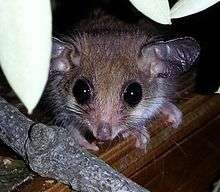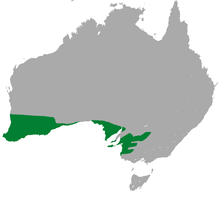Western pygmy possum
| Western pygmy possum[1] Temporal range: Late Pleistocene – Recent | |
|---|---|
 | |
| Captive western pygmy possum at Cleland Wildlife Park, South Australia 2013 | |
| Scientific classification | |
| Kingdom: | Animalia |
| Phylum: | Chordata |
| Clade: | Synapsida |
| Class: | Mammalia |
| Infraclass: | Marsupialia |
| Order: | Diprotodontia |
| Family: | Burramyidae |
| Genus: | Cercartetus |
| Species: | C. concinnus |
| Binomial name | |
| Cercartetus concinnus (Gould, 1845) | |
 | |
| Western pygmy possum range | |
The western pygmy possum (Cercartetus concinnus), also known as the southwestern pygmy possum or the mundarda, is a small marsupial found in Australia. Genetic studies indicate its closest relative is probably the eastern pygmy possum,[3] from which its ancestors diverged around eight million years ago.[4]
Description
The western pygmy possum is unusual in Cercartetus, as, unlike its grey relatives, the fur over most of its body is a bright cinnamon colour.[5] It has pure white underparts, which also distinguishes it from its relatives, and has a relatively indistinct patch of darker fur in front of the eyes. It possesses larger, oval ears, large eyes, and long whiskers. The tail is long and prehensile, and is covered with fine scales, rather than fur. The hind feet have opposable first digits, while all four feet have broad pads at the tips of the toes.[6]
Although small compared with most other possums, it is one of the larger pygmy possums, with adults ranging from 5.7–7.2 cm (2.2–2.8 in) in head-body length with a tail 7.7–8.7 cm (3.0–3.4 in) long. Adult weight ranges from 8–21 g (0.28–0.74 oz). The female has a well-developed pouch, opening to the front, containing six teats. At up to 1.2 cm (0.47 in) in length, the tongue is unusually large for such a small animal.[6]
Distribution and habitat
This possum is vulnerable due to habitat loss and lack of food. It has a patchy distribution which includes southwestern Western Australia, as well as wheat belt areas of South Australia, Kangaroo Island, and Victoria south to Edenhope.[5] It is also found on in far southwestern New South Wales, where it is listed as endangered.[7] It inhabits semiarid woodland, shrubland, and heath, dominated by plants such as bottlebrushes, melaleuca, banksia, and grevillea.[6] Although there had been previously thought to be two subspecies, separated in distribution by the Nullarbor Plain, genetic studies have not revealed any significant difference between the eastern and western populations.[4] Furthermore, while the species is no longer native to the area, fossils from the Nullarbor Plain region are known.[6]
Behaviour and diet
The western pygmy possum is solitary and nocturnal.[5] During the day, they shelter in tree hollows or other natural crevices, birds' nests, or dense vegetation. At night, they travel in search of food or mates, typically moving around 50 m (160 ft) each day, and they may migrate to different areas over the course of a year, depending on local plant resources. They spend most of their time in the trees, using their grasping paws and prehensile tails to grip onto branches, grasp nest materials, and open flowers to access nectar. They have been described as making a rapid chattering noise.[6]
It feeds primarily on nectar and pollen, especially from plants such as melaleuca and eucalyptus, and may play a role in the pollination.[8] It also supplements its diet with insects.[5] Native predators include quolls, snakes, and owls, although in modern times, the animal also falls prey to introduced carnivores such as red foxes and domestic cats.[6]
Western pygmy possums have the ability to enter torpor during inclement or cold weather, enabling them to conserve energy and food reserves. During bouts of torpor, which may last for up to seven days at a time, body temperature falls to within one degree Celsius of ambient, and oxygen consumption to just 1% of normal. They sleep on their fronts, with their ears folded over their eyes, and their long tails coiled beneath their bodies. Compared with other mammals of similar size, they rouse from torpor unusually quickly.[9]
Reproduction
Western pygmy possums can breed throughout the year, although they do so more commonly in the spring, and give birth to litters of four to six young. The mother often carries more than six embryos at a time in her womb, but because she has only six teats, and marsupial young remain attached to an individual teat for much of their early lives, six is the maximum number she is able to rear.[10] Unusually, however, the mother may give birth just two days after weaning a previous litter, with her teats dramatically changing in size to accommodate the smaller young, and the mammary glands reverting to production of colostrum.[6]
The young are still blind when they leave the pouch at around 25 days of age; they initially remain within the nest, and are fully weaned at around 50 days. Females reach sexual maturity at 12 to 15 months old.[6]
Conservation
The species is currently classified as Least Concern by the IUCN. However, several Australian states (New South Wales and South Australia) and individual parks and conservation regions have nationally listed it as Vulnerable, Endangered or Critically Endangered due to the pressure from vegetation clearing, the reduction of food sources (overgrazing of livestock), fire regimes, and introduced predators such as the red fox and feral cats.[11][12]
References
- ↑ Groves, C.P. (2005). Wilson, D.E.; Reeder, D.M., eds. Mammal Species of the World: A Taxonomic and Geographic Reference (3rd ed.). Baltimore: Johns Hopkins University Press. pp. 44–45. OCLC 62265494. ISBN 0-801-88221-4.
- ↑ Burbidge, A.; Morris, K.; Ellis, M.; van Weenen, J. & Menkhorst, P. (2008). "Cercartetus concinnus". IUCN Red List of Threatened Species. Version 2008. International Union for Conservation of Nature. Retrieved 28 December 2008.
- ↑ Osborne, M.J. & Christidis, L. (2002). "Systematics and biogeography of pygmy possums (Burramyidae: Cercartetus)". Australian Journal of Zoology. 50 (1): 25–37. doi:10.1071/ZO01071.
- 1 2 Pestell, A.J.L.; et al. (2008). "Genetic structure of the western pygmy possum Cercartetus concinnus Gould (Marsupialia: Burramyidae) based on mitochondrial DNA". Australian Mammalogy. 29 (2): 191–200. doi:10.1071/AM07023.
- 1 2 3 4 Menkhorst, Peter (2001). A Field Guide to the Mammals of Australia. Oxford University Press. p. 88.
- 1 2 3 4 5 6 7 8 Harris, J.M. (2009). "Cercartetus concinnus (Diprotodontia: Burramyidae)". Mammalian Species. 831: 1–11. doi:10.1644/831.1.
- ↑ New South Wales National Parks and Wildlife Service. "Western pygmy-possum (Cercartetus concinnus) approved recovery plan" (PDF). Retrieved 10 June 2011.
- ↑ Pestell, A.J.L. & Petit, S. (2007). "Diet of the western pygmy possum, Cercartetus concinnus Gould (Marsupialia: Burramyidae), at Innes National Park, South Australia, and evaluation of diet sampling methods". Australian Journal of Zoology. 55 (5): 275–284. doi:10.1071/ZO07037.
- ↑ Geiser, F. (1987). "Hibernation and daily torpor in two pygmy possums (Cercartetus spp., Marsupialia)". Physiological Zoology. 60 (1): 93–102. JSTOR 30158631.
- ↑ Ward, S.J. (1998). "Numbers of teats and pre- and post-natal litter sizes in small diprotodont marsupials". Journal of Mammalogy. 79 (3): 999–1008. doi:10.2307/1383108. JSTOR 1383108.
- ↑ Harris, J. (2009). "Cercartetus concinnus (Diprotodontia: Burramyidae)". Mammalian Species. 831 (1-11). doi:10.1644/831.1.
- ↑ "Threatened Species at Cleland Wildlife Park" (PDF). Discovery Circle.
External links
- Western Wildlife including photo
- Images: skulls (including C. concinnus) on Museum Victoria website
- Images: Australian mammal images (including C. concinnus) on Museum Victoria website
